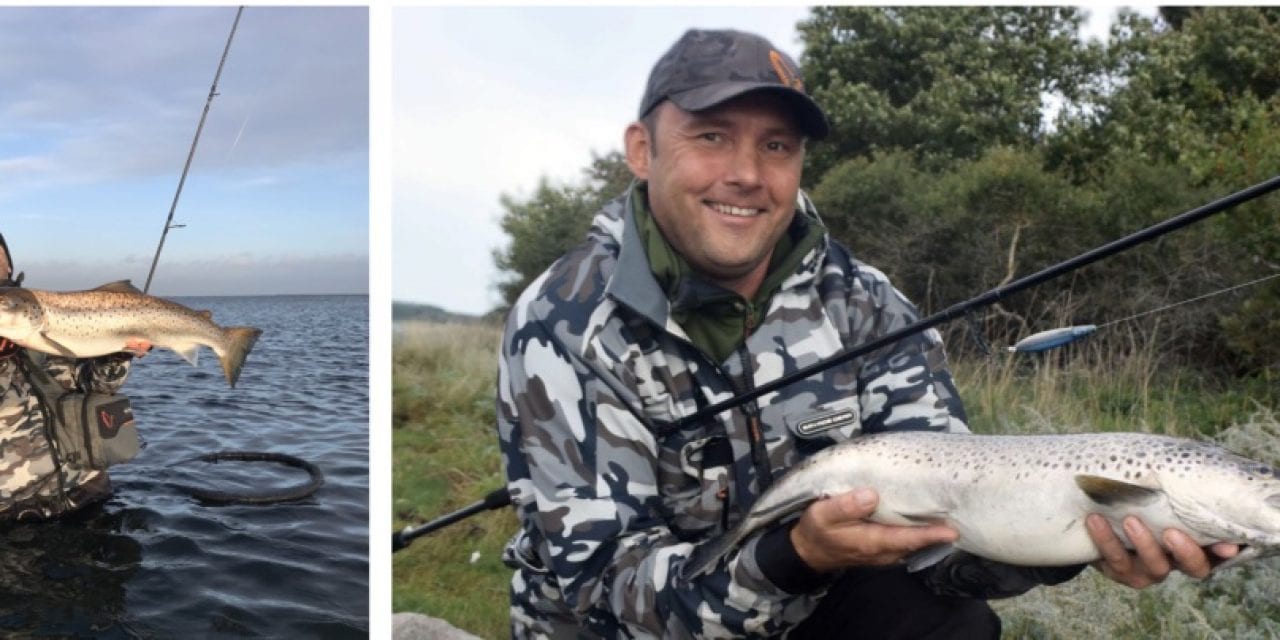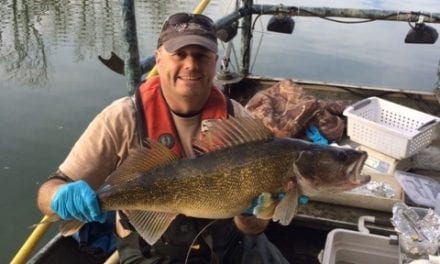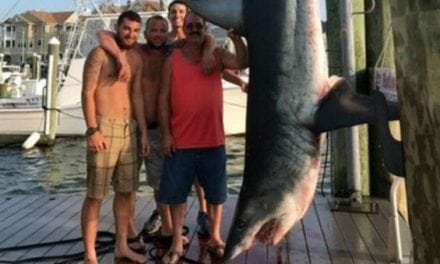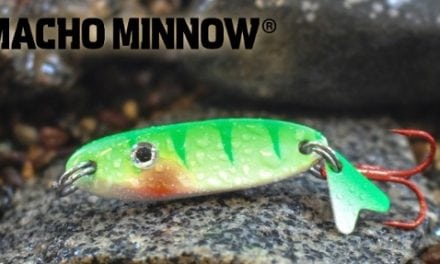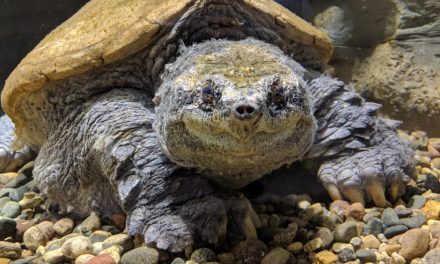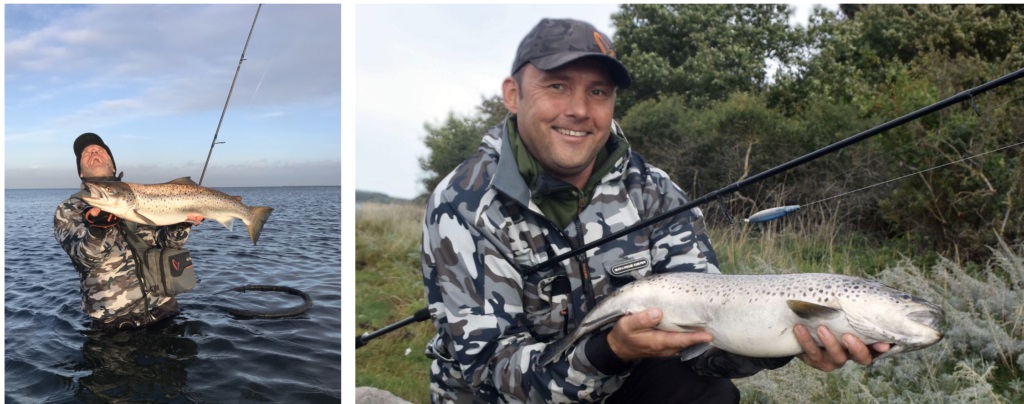
No matter where you are, coastal spinning is super effective – If you know how to do it. In the Scandinavian waters, seatrout are abundant and the fishermen have fine-tuned their tackle to match the conditions. Learn how the Scandinavians do it.
The seatrout
When it exits the river, it has already changed the darker brown colors with perfectly shiny silver scales. This makes it able to better camouflage itself in the big ocean. Coming from a relatively safe river, it now has to navigate through dangerous waters and to escape dangers lurking along the coastline. Big predatory fish, hungry birds and huge seals are waiting for the seatrout. To minimize these dangers the seatrout has to come up with a strategy to survive. Most of the seatrout choose to swim close to the shoreline. This will make them vulnerable to bird attacks, but the seals and bigger predatory fish will keep in the deeper water. This does not mean that seatrout cannot be found in deep water, but the majority of fish will stay close to shore. Here it will hunt for shrimp, smaller fish like goby, stickleback, sandeel and other snacks. The seatrout thrives in along the coastline. It is a pantry and here it grows big much faster than in the river where competition for small insects can be very high. The coastal life of a seatrout can easily be transferred into other species like seabass.
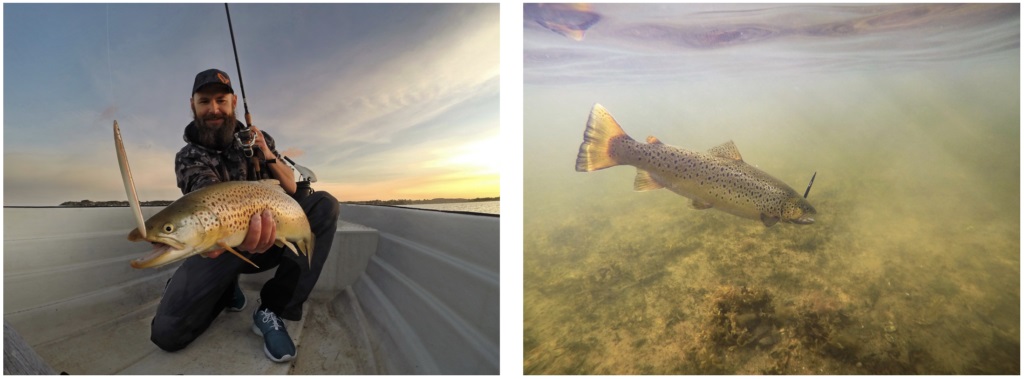
Where will it be?
What is it that the seatrout has to have in order to be in the perfect conditions? It needs safety, so predators will not ambush it. It needs the right temperature in order to function and then it needs food to grow big and fat. These three characteristics are key points if you want to catch more fish. So how does it get safety? As mentioned above, it will often cruise in the shallows in order to escape bigger predators. When it needs more safety it camouflages itself in the weeds. This makes it harder for predatory fish to ambush, but also creates an almost perfect environment, so hungry birds really have to look for the seatrout. In here the prey also had the same idea of hiding. Therefore the seatrout will have a good source of food close to the weeds. Another way to feel more comfortable for the fish is to be in slightly murky waters. The seatrout feel much better when the visibility is between 1-2 meters. If the water is too clear the seatrout have a lot of thinking time and it becomes harder to fool. This is when the perfect imitation like the Line Thru Sandeel and Line Thru Stickleblade comes in handy. Ultra realistic lures makes a huge different between success and failure. When the visibility is too low it, of course, it becomes harder for the fish to hunt. Slightly murky water will make the seatrout strike harder and you will catch more fish in these conditions. Last but not the least important parameter is the temperature. Think about it? If your fingers were freezing from the cold wind, then you would probably search for the best option to feel warm again. The same applies for the seatrout. The spectrum the seatrout feels good in is between 6 to 18 degrees and the best and most optimal temperature, where it is the most active, is between 12-14 degrees.
Gear
The rod and reel have to fit the conditions you are fishing. Long casts can be a lifesaver, but often it is better to be accurate when a fish is showing in a distance. A 9 or 10 foot with a casting weight of 10-30 gr will cover most fishing conditions you will encounter, when targeting seatrout. The Savage Gear Browser rod is a favourite in Scandinavia because of its endurance and saltwater rigged guides. The reel of course has to be saltwater-resistant. Seatrout fishing requires a lot of casting and for this reason a lightweight reel is preferred. Though, you still have to choose a reel for your fishing technic. A small reel is light, but a bigger reel with a larger spool will pick up more line when spinning fast. Spinning fast can be a game changer, so therefore it can be an advantage to choose a bigger reel model. We will get to that soon. When spooling on a line it has to fulfill two things. One is that you have to be able to cast far. The ocean is big and you have to cover as much water as possible. Number two is that the wind is almost always a factor when fishing on the coast. Using a thinner line makes it easier to connect to your lure and strike harder when the fish takes the bait. The most common line for Scandinavian fishing is braided line in 0,12 to 0,15 mm. Thicker line is rarely needed. You can even go down to 0,10 mm, when longer casts are required.
The hanging spin-stop
One of the techniques, which the Scandinavians love, is the spin-stop when seatrout fishing. This technique is known all across the world, but the Scandinavians have a very special way of doing it. It is called the hanging spin-stop. The idea is to make the metal lure rotate slowly during the spin stop. This creates a lot of vibration and flashing. It is a deadly technique, but it also requires the right lure to make it work. A trusted lure is the Savage Gear Line Thru Seeker. This lure has great casting abilities caused by the heavy lower section. The flat upper body makes it flash during retrieve. When stopped, it slowly rotates to the side. Remember to keep a connection to the lure and feel the vibrations from the rotating Line Thru Seeker. If you do not have that connection, the lure will look like a stone falling towards the bottom. How you start to spin again is also a well-kept secret amongst Scandinavian seatrout anglers. Think about it like a kitten. If you want to get the kitten to attack your ball of yarn, then how would you do so? If you swing it slowly back and forth the kitten will fall asleep, but if you make small aggressive twitching, the kitten will have a provoked reaction. The same applies for the fish we are fishing for. When starting to spin again, make an aggressive twitch. This will cause the Line Thru Seeker to jump to the side and this is the moment when the line becomes tight and you will have a bent rod.
Coastal speedspin
What is more visible and noisy than an escaping baitfish? Topwater action is always attracting predators and the seatrout and seabass are both predators that will not pass on an easy meal. It is not just an effective way of fishing, but also provides you with the most explosive topwater action. As in the word speedspin, speed is everything. In order to imitate an escaping fish, you have to spin fast. And by fast, it not just normal fast, but really fast. Actually you should spin around a speed of 15 km/h. If you do not want to be exhausted within 10 min, then use a larger reel. This will help you to spin faster without draining yourself from energy. The lure has to be very torpedo shaped. Fishing a flat metal lure will have a jumping effect and the fish will never fall for it. The Savage Gear 3D Line Thru Sandeel is just great for this method. It is slim, but well balanced, so it can handle the speed needed to keep the direction. The line thru model is also great, because it will glide up the line and provide a safer hookup. This speedspin technique can do two things. It can help locate the fish. Often the fish will not hit the bait and hooking the fish can be really hard, but when you know where the fish are, you can slow down and fool it just below the surface. This will create safer hooking and more caught fish.
The 3D Line Thru Sandeel is perfect for speedspin when seatrout or seabass fishing. Slim, fast and ultra realistic! Check out the magic in the video below. A must see!
Last meter
The last meter can make a huge difference between a good day and a great day. Using fluorocarbon as the last meter has more advantages. The fluorocarbon is more stiff and durable, which can come in handy when fishing with line thru lures. The line thru lures are always wearing the line from its wiggling and the fluorocarbon is a much better last meter than the braided mainline. The stiffness a fluorocarbon provides keeps the lures and hooks from tangling and making a mess. On top of this, the fluorocarbon is much more invisible than braided line or regular monofilament. There are a number of different ways to connect the braided and fluorocarbon line. You can tie a double uni knot, which is a great knot for strength and reliability. Or you can connect the two lines with a swivel or an oval ring.
Fish like no tomorrow
Claiming something is the best way to fish is impossible, but what seems pretty clear when we talk to the most successful seatrout anglers in Scandinavia, is that one approach is out-fishing the other ones. Standing in one spot can be the right thing to do in some cases, but it is clear that if you want to catch more, you have to search for the fish by walking all the time. First of all you get the chance to fish a lot of spots and second, you will present your lure for new fish all the time. If you find a school of fish you will often be successful in catching a few of them. After that it becomes harder, when the fish see their brothers disappear. The best way to overcome this is to change lures all the time. Change sizes, colors, model and tactics. Then you will be more successful and you will have just as much success as the Scandinavians.
The post SEATROUT FISHING – THE SCANDINAVIAN WAY appeared first on .

